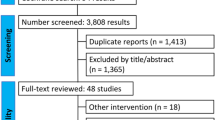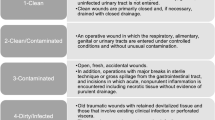Abstract
Background
Various types of dressing materials are available for wound care following hip and knee arthroplasty. However, it is unclear if one material is more beneficial than the others in terms of wound complications and fluid handling capacity.
Research questions
We performed a meta-analysis of randomized controlled trials comparing alternative wound dressing materials for the post-operative management of wounds following THA and TKA with respect to (1) incidence of wound complications including infection and (2) fluid handling capacity.
Methods
Randomized controlled trials comparing alternative dressing materials, for post-operative management of wounds following TKA and THA were included in the review. Databases searched included the MEDLINE and the EMBASE from inception to February 2017. Two authors performed study selection, risk of bias assessment and data extraction. Where levels of clinical and statistical heterogeneity permitted, data were pooled for meta-analysis.
Results
Twelve randomized trials with data for the primary outcome were identified. Data were available for meta-analysis for two comparisons. Wounds managed with film dressings (odds ratio, 0.35; 95% confidence interval [CI], 0.21–0.57) or with hydrofiber dressings (odds ratio, 0.28; 95% confidence interval [CI], 0.20–0.40) were significantly less likely to have wound complications than those managed with passive dressings. There was no evidence that any dressing significantly reduced surgical-site infection rates compared with any other dressing. Hydrofibre dressings showed better fluid handling capacity than passive dressings in terms of mean number of dressing changes (mean difference 1.36; 95% confidence interval [CI], 0.15–2.57) and number of patients requiring early dressing change (odds ratio, 8.60; 95% confidence interval [CI], 4.68–15.83).
Conclusion
The evidence available in the current literature suggests that advanced dressings such as film and Hydrofibre dressings have fewer wound complications and better fluid handling capacity. However, insufficient evidence is available to determine whether the use of these advanced dressings reduce periprosthetic joint infection.





Similar content being viewed by others
References
Sweeney IR, Miraftab M, Collyer G (2012) A critical review of modern and emerging absorbent dressings used to treat exuding wounds. Int Wound J 9(6):601–612. doi:10.1111/j.1742-481X.2011.00923.x
Hopper GP, Deakin AH, Crane EO, Clarke JV (2012) Enhancing patient recovery following lower limb arthroplasty with a modern wound dressing: a prospective, comparative audit. J Wound Care 21(4):200–203. doi:10.12968/jowc.2012.21.4.200
Cosker T, Elsayed S, Gupta S, Mendonca AD, Tayton KJ (2005) Choice of dressing has a major impact on blistering and healing outcomes in orthopaedic patients. J Wound Care 14(1):27–29. doi:10.12968/jowc.2005.14.1.26722
Bredow J, Oppermann J, Hoffmann K, Hellmich M, Wenk B, Simons M, Eysel P, Zarghooni K (2015) Clinical trial to evaluate the performance of a flexible self-adherent absorbent dressing coated with a soft silicone layer compared to a standard wound dressing after orthopedic or spinal surgery: study protocol for a randomized controlled trial. Trials 16:81. doi:10.1186/s13063-015-0599-z
Ravenscroft MJ, Harker J, Buch KA (2006) A prospective, randomised, controlled trial comparing wound dressings used in hip and knee surgery: Aquacel and Tegaderm versus Cutiplast. Ann R Coll Surg Engl 88(1):18–22. doi:10.1308/003588406x82989
Langlois J, Zaoui A, Ozil C, Courpied JP, Anract P, Hamadouche M (2015) Randomized controlled trial of conventional versus modern surgical dressings following primary total hip and knee replacement. Int Orthop 39(7):1315–1319. doi:10.1007/s00264-015-2726-6
Wong KL, Peter L, Liang S, Shah S, Johandi F, Wang W (2015) Changes in dimensions of total knee arthroplasty anterior knee dressings during flexion: preliminary findings. Int J Orthop Trauma Nurs 19(4):179–183. doi:10.1016/j.ijotn.2015.06.002
Dillon JM, Clarke JV, Deakin AH (2007) Correlation of total knee replacement surgery wound dynamic morphology and dressing material properties. J Biomech 40(Suppl. 2):S61
Gupta SK, Lee S, Moseley LG (2002) Postoperative wound blistering: is there a link with dressing usage? J Wound Care 11(7):271–273. doi:10.12968/jowc.2002.11.7.26413
Horan TC, Andrus M, Dudeck MA (2008) CDC/NHSN surveillance definition of health care-associated infection and criteria for specific types of infections in the acute care setting. Am J Infect Control 36(5):309–332. doi:10.1016/j.ajic.2008.03.002
Higgins JP, Altman DG, Gotzsche PC, Juni P, Moher D, Oxman AD, Savovic J, Schulz KF, Weeks L, Sterne JA (2011) The Cochrane Collaboration’s tool for assessing risk of bias in randomised trials. BMJ 343:d5928. doi:10.1136/bmj.d5928
Koval KJ, Egol KA, Polatsch DB, Baskies MA, Homman JP, Hiebert RN (2003) Tape blisters following hip surgery. A prospective, randomized study of two types of tape. J Bone Joint Surg Am 85-a(10):1884–1887
Lawrentschuk N, Falkenberg MP, Pirpiris M (2002) Wound blisters post hip surgery: a prospective trial comparing dressings. ANZ J Surg 72(10):716–719
Dobbelaere A, Schuermans N, Smet S, Van Der Straeten C, Victor J (2015) Comparative study of innovative postoperative wound dressings after total knee arthroplasty. Acta Orthop Belg 81(3):454–461
Koval KJ, Egol KA, Hiebert R, Spratt KF (2007) Tape blisters after hip surgery: can they be eliminated completely? Am J Orthop (Belle Mead, NJ) 36(5):261–265
Abuzakuk TM, Coward P, Shenava Y, Kumar VS, Skinner JA (2006) The management of wounds following primary lower limb arthroplasty: a prospective, randomised study comparing hydrofibre and central pad dressings. Int Wound J 3(2):133–137
Burke NG, Green C, McHugh G, McGolderick N, Kilcoyne C, Kenny P (2012) A prospective randomised study comparing the jubilee dressing method to a standard adhesive dressing for total hip and knee replacements. J Tissue Viability 21(3):84–87. doi:10.1016/j.jtv.2012.04.002
Springer BD, Beaver WB, Griffin WL, Mason JB, Odum SM (2015) Role of surgical dressings in total joint arthroplasty: a randomized controlled trial. Am J Orthop (Belle Mead, NJ) 44(9):415–420
Ravnskog FA, Espehaug B, Indrekvam K (2011) Randomised clinical trial comparing Hydrofiber and alginate dressings post-hip replacement. J Wound Care 20(3):136–142. doi:10.12968/jowc.2011.20.3.136
Harle S, Korhonen A, Kettunen JA, Seitsalo S (2005) A randomised clinical trial of two different wound dressing materials for hip replacement patients. J Orthop Nurs 9(4):205–210. doi:10.1016/j.joon.2005.09.003
Galat DD, McGovern SC, Larson DR, Harrington JR, Hanssen AD, Clarke HD (2009) Surgical treatment of early wound complications following primary total knee arthroplasty. J Bone Joint Surg Am 91(1):48–54. doi:10.2106/JBJS.G.01371
Collins A (2011) Does the postoperative dressing regime affect wound healing after hip or knee arthroplasty? J Wound Care 20(1):11–16. doi:10.12968/jowc.2011.20.1.11
Tustanowski J (2009) Effect of dressing choice on outcomes after hip and knee arthroplasty: a literature review. J Wound Care 18(11):449–450, 452, 454, passim. doi:10.12968/jowc.2009.18.11.44985
Chowdhry M, Chen AF (2015) Wound dressings for primary and revision total joint arthroplasty. Ann Transl Med 3(18):268. doi:10.3978/j.issn.2305-5839.2015.09.25
Dillon JM, Clarke JV, Deakin AH, Nicol AC, Kinninmonth AWG (2007) Correlation of total knee replacement surgery wound dynamic morphology and dressing material properties. J Biomech 40:S570. doi:10.1016/S0021-9290(07)70560-2
Clarke JV, Deakin AH, Dillon JM, Emmerson S, Kinninmonth AW (2009) A prospective clinical audit of a new dressing design for lower limb arthroplasty wounds. J Wound Care 18(1):5–8, 10-11. doi:10.12968/jowc.2009.18.1.32128
Kloeters O, Schierle C, Tandara A, Mustoe TA (2008) The use of a semiocclusive dressing reduces epidermal inflammatory cytokine expression and mitigates dermal proliferation and inflammation in a rat incisional model. Wound Repair Regen 16(4):568–575. doi:10.1111/j.1524-475X.2008.00404.x
Author information
Authors and Affiliations
Corresponding author
Ethics declarations
Conflict of interest statement
Gaurav Sharma: No conflict of interest with this work.
Sang Wook Lee: No conflict of interest with this work.
Oliver Atanacio: No conflict of interest with this work.
T.K. Kim: Consultant for: Smith & Nephew, B.Braun-Aesculap.
J. Parvizi: Board membership Journal of Arthroplasty, Journal of Bone and Joint Surgery, Bone and Joint Journal, Philadelphia Orthopaedic Society, Eastern Orthopaedic Association, CD Diagnostics, Muller Foundation, 3 M; Consultant for Zimmer, Smith & Nephew, ConvaTec, TissueGene, CeramTec, Medtronic; Royalties from Elsevier, Wolters Kluwer, Slack, Datatrace, Jaypee Publishers; Stock options - Intellectual properties: Hip Innovation Technologies, CD Diagnostics, PRN.
This work was performed at the Seoul National University Bundang Hospital.
Rights and permissions
About this article
Cite this article
Sharma, G., Lee, S.W., Atanacio, O. et al. In search of the optimal wound dressing material following total hip and knee arthroplasty: a systematic review and meta-analysis. International Orthopaedics (SICOT) 41, 1295–1305 (2017). https://doi.org/10.1007/s00264-017-3484-4
Received:
Accepted:
Published:
Issue Date:
DOI: https://doi.org/10.1007/s00264-017-3484-4




